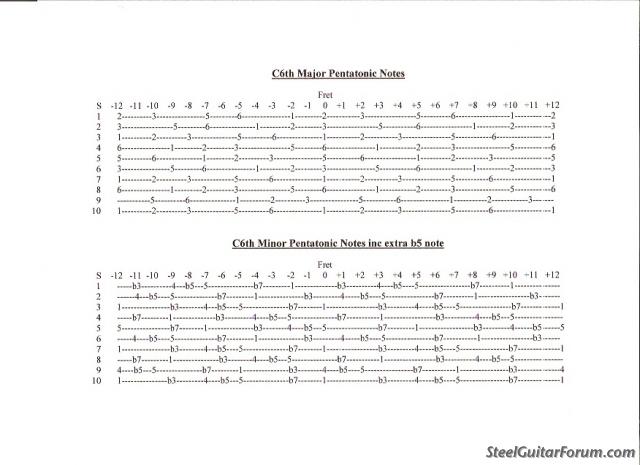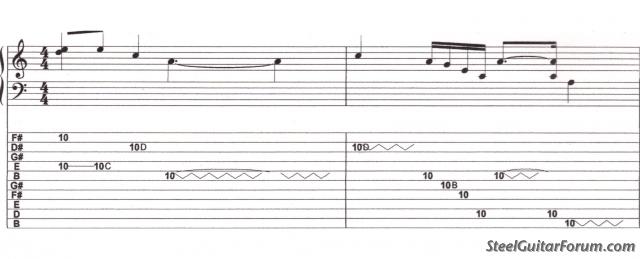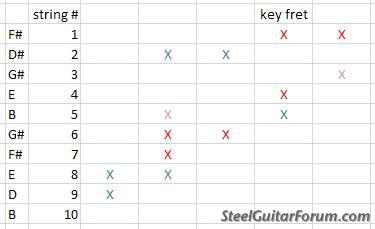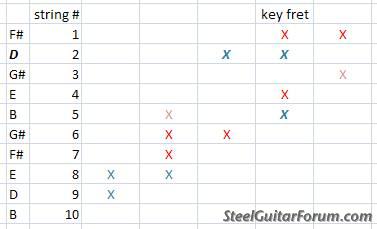Page 2 of 4
Posted: 7 Jul 2008 11:19 am
by Don Benoit
Great information. Thanks
Posted: 7 Jul 2008 7:37 pm
by Marc Friedland
To anyone who is interested:
If you would like my home-made charts showing easy ways to play major, minor, 7th scales etc, on the E9 neck, send me an email to Marc4Music@aol.com
Many of you have probably already seen these. A couple of years ago I made them widely available for free to everyone on the Forum and eventually sent them out to about 500 steelers around the world.
-- Marc
Posted: 9 Jul 2008 8:07 pm
by Jim Sliff
ecause this approach gives only single notes, with little or no harmony, it is of little interest to most steelers. They can figure that out for themselves easily enough;
It may be of little interest to most steelers (who are probably playing country) but it is FAR from stuff "They can easily figure out for themselves". That's an assumption that's way off-base in my opinion; just look at ANY other instrument and the amount of lesson material that's devoted to learning single-note melody lines, whether blues, rock, jazz, whatever - steel players don't instantly gain the ability to "figure out" single-note stuff because they play steel. Sorry - playing steel doesn't make you a musical genius. Take 5 minutes and play the head to Yes's "Long Distance Runaround" - or annoy guitar store employees (if you can find a steel) and play just the melody line to Stairway to Heaven. How about playing a little bit of "Seven Comes Eleven" - piece of cake, huh?
Time again for some steelers to step off the pedestal.
Ben - yeah, you did have a good system going with the "boxes", and it's really a shame more players just don't "get it". Steel would be used far more often in more styles of music if players would step outside their comfort zone, but there are far too many "woe is us" threads lamenting the state of country music, instead of threads along the lines of " how can we find a way to fit our instrument into modern music?"...and associated ways of attracting more players.
Posted: 9 Jul 2008 9:18 pm
by David Doggett
As I clearly said, Jim, I wasn't defending the existing steel instructional material, just explaining it. The vast majority of beginning Pedal steelers are proficient guitarists before taking up steel. So most steel instruction really is "Introduction to Country Pedal Steel Guitar for Experienced Country Guitar Players." And traditionally most beginning pedal steelers already have some experience with single string picking on Dobro or lap steel. So except for a little single string speed picking, they are mostly interested in learning moving harmony with two and three fingers and pedal and knee combinations all up and down the neck, for which boxes are inadequate and tab is essential.
The best analogy I can think of is that people generally are experienced piano players before they attempt to learn to play a grand pipe organ with multiple keyboards, a couple of octaves of foot pedals, and dozens of stops. So I would imagine there are no grand organ instruction manuals that start out with "Row, Row Your Boat" and "Twinkle, Twinkle Little Star."
But you are right, for the advancement of the instrument, it would be nice to have some instruction material for rock guitarists learning pedal steel. And it should include some familiar rock material. There are enough steelers out there who play some rock and could do that. So some day it could happen.
Posted: 10 Jul 2008 6:40 am
by Don Benoit
Larry Behm has a video that shows his approach to rock pockets and licks. I have that video and I will check it out again.
Posted: 10 Jul 2008 7:16 am
by Ben Jones
I understand and accept the reasons why this stuff aint in beginers instruction. davids explanations makes good sense to me. I think many agree that it would be good to update the beginners instructional material for todays beginners to at least briefly explain this stuff as we have attempted to do in this thread. The question is who is gonna do it and how can it be made the new standard, rather than just another obscure course offered that few know about? right now when you come to the instrument...its Winnies book and a handful of dvds that while very good at explaining country dont touch on this stuff at all for the most part.
tough question. tough job...but probably one that needs to be done at some point.
Posted: 10 Jul 2008 7:26 am
by Ken Metcalf
Take a look at Mickey Adams (singpilot) on utube, Minor chords Moondance, In Key of C w/ Chords Dm, Am, Gm
Anything you can figure out on the first two strings of a 6 string guitar, Then take it to the 4th string E and 5th string B same as the six string.
Posted: 10 Jul 2008 10:00 am
by Ben Jones
I LOVE mickeys videos.
I'd like to see him do a "blues" or "rock" one.
Posted: 10 Jul 2008 11:08 am
by b0b
Don't forget that you have the notes of an E Major slide guitar tuning on strings 4, 5, 6, 8 and 10. Any of the pockets that you use for E Major bottleneck guitar are right there.
Posted: 10 Jul 2008 12:40 pm
by Don Benoit
Here is a fretboard chart that I made up yesterday showing the note on a C6th neck for the major and minor pentatonic notes in the Nashville number system. I added the #5 note to the chart. The zero position is where the key is. Any comments? I could map out my own pockets here.

Posted: 10 Jul 2008 12:42 pm
by Don Benoit
Note in my last post where Jeff's OBAIL pocket is. It is very obvious that he used the major pentatonic scale.
Posted: 10 Jul 2008 3:59 pm
by P Gleespen
I'm sure I'll feel silly after you answer this, but what's an "OBAIL" pocket?
Posted: 10 Jul 2008 4:11 pm
by Don Benoit
Patrick
It comes from the Jeff Newman Advanced C6th course, It stands for "O Boy Am I Lost". I can't really tell you where the pocket is as it is copy protected. It involves the 5 major pentatonic notes in any key which are common to some chord changes. So if you play those notes and you don't know what chord changes come up in the rest of the band, then supposedly you just keep playing combinations of those 5 notes and it will sound OK. (Most of the time).
Posted: 10 Jul 2008 7:31 pm
by David Doggett
b0b wrote:Don't forget that you have the notes of an E Major slide guitar tuning on strings 4, 5, 6, 8 and 10. Any of the pockets that you use for E Major bottleneck guitar are right there.
Yes, that's the ticket on E9. Also, with the A and B pedals down, you have an slide guitar tuning in A with the 1 on the top on string 3. So that's on strings 3, 4, 5, 6, 8 and 10. And with the A pedal and F lever combination, you have an E slide guitar tuning at the 3rd fret on strings 3, 4, 5, 6, 8 and 10, with the roots on 5 and 10, and a 5th on top, like a Dobro tuning. And let off on the F lever and you have a pentatonic minor tuning.
Posted: 10 Jul 2008 7:38 pm
by David Doggett
That C6 chart of Don's gets more useful for blues-rock if you consider it with the 4th pedal down. That raises the 6ths on strings 4 and 8 to b7s, which turns it into a much more blues friendly C7 tuning similar to the E7 tuning of Sacred Steelers.
[Edited after seeing b0b's correction]Oops. I was reading off a chart and picked the wrong change. As b0b says, for the b7 you need a lever that raises the 6ths a half-step to Bb. It's a standard Buddy Emmons C6 lever that many people have, usually on LKR.
Posted: 10 Jul 2008 8:35 pm
by b0b
David Doggett wrote:That C6 chart of Don's gets more useful for blues-rock if you consider it with the 4th pedal down. That raises the 6ths on strings 4 and 8 to b7s, which turns it into a much more blues friendly C7 tuning similar to the E7 tuning of Sacred Steelers.
Huh? The 4th pedal raises both A's to
B, which is a
major 7th. It never sounded bluesy to me!

A lot of people have a knee lever that raises the A's to Bb. Maybe that's what you meant.
Posted: 10 Jul 2008 11:05 pm
by Bo Legg
This is not in reference to or a put down to anyone’s thread here. Just something you might conceder.
The penta scale falls right in place across the neck in so many places on the E9 neck that I don’t even think in terms of pockets or boxes as sometimes referred to. Take the time. Learn the neck. I use the approach that Stuart Legg worked out for me in regards to the penta scale for blues on E9. Make bends not slides. Don’t sound like a slide guitar? Try to sound similar to BB King. To get this sound of course you need to learn some penta blues licks by BB King, Albert King, etc. and make your bends with the pedals or knees and play within the penta scale without moving the bar except for a lot of vibrato.
Here is an example: This is a BB king lick in the Key of A in just one of the many places you can make pedal bends and play the penta scale without moving the bar except for vibrato.

Posted: 11 Jul 2008 8:21 am
by Ben Jones
Bo's lick is what i was talkin bout with the C pedal movement I am hearing. seems to be used alot like guitarists use our bends. i hear some rolling off of C to B pedal alot too
Im not familiar with bottleneck and so i have a question.
Are bottleneck slide pockets different from standard guitar pockets somehow? I would think they would contain exactly the same notes? I dont understand how bottleneck pockets apply to psg (especially since boittleneck is often done in an open tuning). I google searched for bottleneck and slide guitar pockets and came up with a goose-egg. pardon my ignorance.
ya know if i had voodoo chile...I'd have a good 50% of the licks what i want.
Dear RR, please write a beginners course. ...thanks , you pal Ben
Posted: 11 Jul 2008 9:13 am
by b0b
This is a no-pedals pocket that I use a lot for blues and rock.

The "key fret" would be 8 for C, 12 for E, etc.
Also, I often flat the second string to D with a knee lever, which brings those two notes up one fret for convenience in a descending line:

Posted: 11 Jul 2008 10:59 am
by David Doggett
Ben Jones wrote:Are bottleneck slide pockets different from standard guitar pockets somehow? I would think they would contain exactly the same notes? I dont understand how bottleneck pockets apply to psg (especially since boittleneck is often done in an open tuning). I google searched for bottleneck and slide guitar pockets and came up with a goose-egg. pardon my ignorance.
I tried a Google search for (slide, bottleneck) guitar (boxes, pockets). Amazingly, at least in the first three pages of the search results I found only one place for these (
click here).
Maybe Jim Sliff can enlighten us, since he always claims the 6-string instruction world is full of pocket diagrams, and the steel world is woefully provencial without them.
Bottleneck guitar pockets are like regular guitar pockets, except the tunings are different, so the same notes are in different places. Bottleneck pockets are certainly related to blues pockets on pedal steel, because they both use open tunings. Much blues is played on pedal steel using the open strings without pedals and levers, as if it is a 10- or 12-string lap steel. That is what is being called single string or single note picking in this thread. Robert Randolph takes this approach. You can see him play whole blues or gospel songs on his E7 tuning without ever hitting a pedal, although he might be hitting levers (it's usually hard to tell).
But Bo's example uses both single note picking and some pedal and lever bends. But notice it is all at the 10th fret. So a box diagram would just show a bunch of dots all lined up on the 10th fret, and you would have to figure out some way to show the pedal and lever bends. And what would you do about the situation where a note is hit on an open string, and then at the same fret the same string is used for the next note with a pedal or lever bend added. These two notes would be on top of each other in a box diagram. This is exactly my point. Bo's tab elegantly shows what a box diagram can't. The pedal steel world is different from the regular guitar world, and even the lap steel world.
Of course a good case can be made for beginning pedal steel instruction with some single string and single note examples without any pedals or levers, strictly as a pedagogical tool. But that approach would very quickly be a deadend that would greatly limit the beginners progress to lap steel licks. I for one am willing to forgive the writers of pedal steel instruction materials for the assumption that most people seek such material to learn to use the pedals and levers, right from the start. For that you need tab. Tab can also show the single string and single note stuff. And tab is a very standard part of regular guitar instruction material. In fact, looking through Guitar Player magazine, you mostly only see tab for regular guitar licks - box diagrams are rare.
Somehow, I don't think the absence of box diagrams is what keeps guitar players from taking up pedal steel. The absence of blues and rock instruction for beginners almost certainly is a factor - that, plus the high cost of the instrument because of its greater mechanical complexity and low volume production.
Posted: 11 Jul 2008 4:14 pm
by Ben Jones
bOb...THATS IT!! exactly. the next position up from that would be the one most guitarists would tackle as their first "pocket" and how you have it diagramed is exactly how it its most prevalant in the 6 string lit. Thank you for those diagrams, they WILL be helpful...got the next position?

I actually have these pockets found on my own but yours are slightly different than mine thus far. sometimes when you find things on your own...they can get a little funky (i learned so much zeppelin and stones as a kid in the wrong tunings its not even funny, crazy fingerings hehe) so its good to see how others do it...great to see actually.
David-6 string diagrams are abundant, just not any bottleneck ones that i could find. I dont think you have to cater to guitarists specifically or that the lack of box diagrams will prevent anyone who has a serious interest in the instrument from learning...its just a lil more welcoming and easier and familiar for guitarists and as you know Im sure, this is where a good chunk of new players are coming from... the guitar. a little more modern and familiar music would also help grease the wheels for the youngins. I'm sure its no emergency, just something to maybe consider should someone else seek to update the beginers materials that are most commonly available.
Posted: 11 Jul 2008 5:59 pm
by David Doggett
Well, actually, some people think maybe it is an emergency. A few months back b0b did a poll of the age of Forum members. Seems like three-quarters of us are aging baby boomers. Even in today's country music, steel is still there, but no way near as pervasive and dominant in the mix as it once was. In the '60s and early '70s, there was a surge of pedal steel in rock, mostly in the form of country rock, but even in things like Elton John's "Tiny Dancer," a huge top 40 hit, with B.J. Cole on pedal steel. I guess that's where all us baby boomer steelers came in. The smattering of interest of roots rockers in steel, mostly lap steel, today is nothing like in years past. Robert Randolph is the one exception.
Posted: 12 Jul 2008 6:03 am
by Don Benoit
Thanks bOb for the pockets chart.
Posted: 12 Jul 2008 7:47 am
by b0b
Ben Jones wrote:bOb...THATS IT!! exactly. the next position up from that would be the one most guitarists would tackle as their first "pocket" and how you have it diagramed is exactly how it its most prevalant in the 6 string lit. Thank you for those diagrams, they WILL be helpful...got the next position?

The "next position" is 3 frets above the key fret and involves a lot of use of the A pedal. I'm at a loss at how to show it because, as others have pointed out, it's pretty much all at the same fret. That's where you'll find The Allman Bros. "One Way Out" solo. It's all at one fret on pedal steel, bouncing on the A pedal to slide the b7 note up to the root on the 5th string.
Posted: 12 Jul 2008 8:31 am
by Ben Jones
David Doggett wrote:Well, actually, some people think maybe it is an emergency. A few months back b0b did a poll of the age of Forum members. Seems like three-quarters of us are aging baby boomers. Even in today's country music, steel is still there, but no way near as pervasive and dominant in the mix as it once was. In the '60s and early '70s, there was a surge of pedal steel in rock, mostly in the form of country rock, but even in things like Elton John's "Tiny Dancer," a huge top 40 hit, with B.J. Cole on pedal steel. I guess that's where all us baby boomer steelers came in. The smattering of interest of roots rockers in steel, mostly lap steel, today is nothing like in years past. Robert Randolph is the one exception.
actually i just said it wasnt an emergency so as not to appear to be beating a dead horse...I mean we've discussed this a couple times a year since Ive been here. I figured you guys were just sick of hearing it. that said tho. most people still come to the steel for country sounds...even myself. Its beautiful and fun stuff. i just wanna be able to rock in addition



